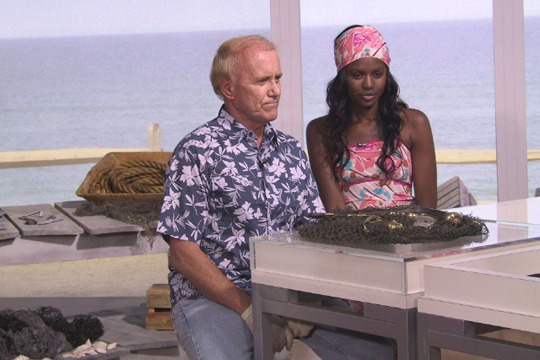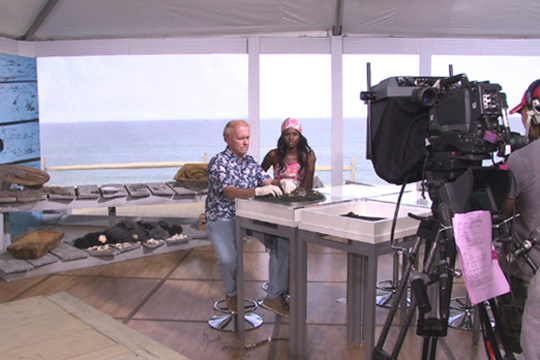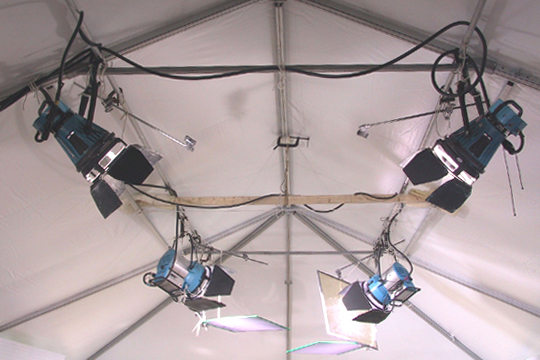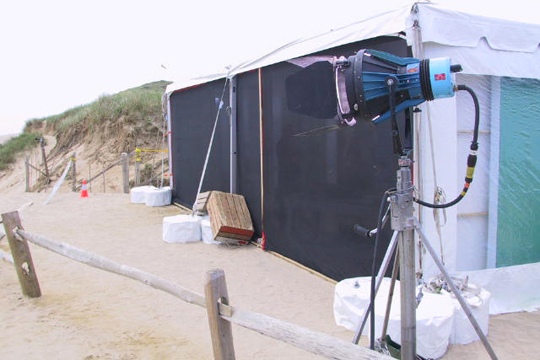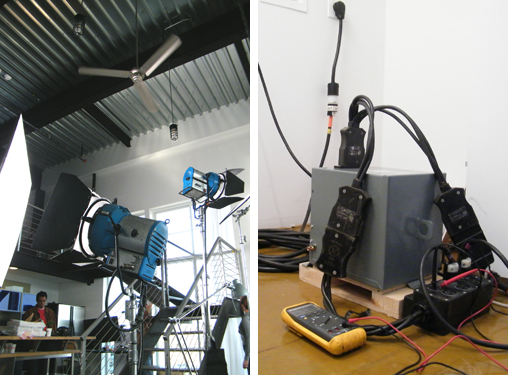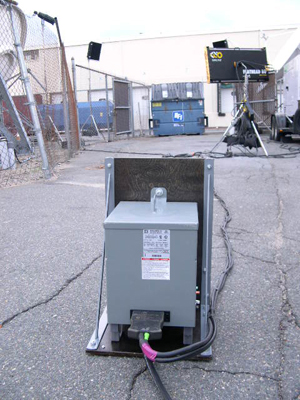I don't think I have it that bad! I have lots of windows, but not giant views like that and nowhere near that level of light. However, Im sure the concepts still apply, my challenge will be to "make do" the best I can with resource I have at my disposal.
It is all the same, whether a high end commercial or independent short, every job is about getting the most production value out of the resources at your disposal. What’s important is being able to recognize what those resources are. For instance, a lot of gaffers may rule out using a 4k HMI par as we did on the Bose still shoot pictured below because they think it requires either a tie-in or renting a generator - both of which can be an expensive proposition. They don’t recognize that common 240V wall receptacles, like the dryer outlet in this loft, can power HMIs as large as 4kw. How it is done depends on whether the 4k has a magnetic or electronic ballast, and whether the electronic ballast has Power Factor Correction (PFC) or not (Arri calls it ALF for Active Line Filter.)
Samples from still shoot for Bose where a 4k HMI par was used to fill talent against windows (Bob Packert Photography)
A multi-volt 4k electronic ballast with Power Factor Correction (PFC) will give you the most options. If you are not familiar with Power Factor Correction, a PFC circuit realigns voltage and current and induces a smoother power waveform at the distribution. As a result, the ballast uses power more efficiently with minimized return current and line noise. 4kw electronic ballasts with PFC (like the Power Gems (PG) 425CDP, the Power-to-Light (P2L) 425LVI, and Arri 2.5/4 EB w/ALF) typically have an operating range of 90–125 & 180-250 Volts. At 120V they will draw approximately 37 Amps. At 240V they will draw 18.5 Amps on each leg of a 240V single phase power supply.
These ballasts draw too much at 120V for a 20A wall outlet. But, fortunately there are a number of 240 volt outlets in a typical house, office, or industrial plant in this country that you can also use to power a 4k with PFC electronic ballast. The most common are air conditioner outlets, dryer outlets, range outlets, outlets for large copy machines in offices, and the outlets for motorized equipment in industrial plants. Many of these household and industrial 240V receptacles use a three wire system (no neutral) because they are designed to power single phase motors or heating elements that draw a perfectly balanced load and return no current because the single phase service legs are 180 degrees out of phase and cancel each other out. Where a 4kw HMI with PFC electronic ballast, operating at 240 Volts draws roughly 18.5 Amps on each leg of a single phase 240V circuit, its’ load is well within the capacity of these circuits. You will also be able to operate a non-PFC 4k electronic ballast off of most 240V receptacles like range plugs and dryer plugs because they draw 26 Amps per leg and these circuits are fused at minimally 30 Amps. Where most magnetic 4k ballasts operate at only 120V and draw 40 Amps this method is not an option with magnetic ballasts. Where 4kw ballasts are typically wired with a 120V 60Amp Bates Plug (Stage Pin), you will need a 120V Female Bates to 240V adapter. I keep an assortment of adapters because all these 240V receptacles use a different pin configuration.
4k & 1.2ks HMI Pars powered from 30A/240V dryer outlet through step-down transformer/distro for Bose still shoot.
The only way to power 120V 4kw HMI magnetic ballasts on wall receptacles is from 240V circuits through a 240v-to-120v step down transformer like the one my company, ScreenLight & Grip (SL&G), manufactures for the Honda EU6500is generators that we modify. Like it does with the enhanced 240V output of our Honda EU6500is Generator, a step down transformer can be used to convert the 240 volts supplied by these industrial and household 240V receptacles to 120 volts in a single circuit that is the sum of the two single phase legs of 30/50 amps each. In other words, out of a “30A/240v” or a “50A/240v” circuit our transformer makes a 60A/120v circuit that is capable of powering bigger 120V lights, like 4kw HMIs with magnetic ballasts (even Quartz 5ks, mini brutes (5850W) or Six Light Mole Par (6000W)).
There are benefits to be gained by powering even 4kw electronic ballasts (PFC or not) on 240V circuits through a 240v-to-120v step down transformer. For instance, you will be able to run additional large lights (like 1.2kws) on the same circuit if, rather than plugging the 4kw electronic ballast directly into the 240 receptacle (operating it at 240V) and monopolizing it, you plug it in through a transformer (operating it at 120 Volts), you will be left with 25 - 37 Amps to power additional lights on the same circuit. That’s a lot of additional power to waste by plugging the 4k directly into the 240V receptacle. And, since an electronic ballast “ramps up” gradually during the striking phase, you don’t have to leave head room as you would with a magnetic ballast. By operating the light through a transformer you can more fully utilize the capacity of the 240V circuit. For example, since the P2L 4/2.5 LVI ballast at 120V operates a 4k HMI luminary at 37 amps, you will still be able to power an additional 1.2kw HMIs (if operated by P2L 575/1200 ballast (11 Amps)), as well as a 800 Joker HMI (if operated by a P2L 800/1200 ballast (8 Amps)), off of the same circuit. That’s a lot of additional light to be gained by not plugging the 4k directly into the 240V receptacle.
A transformer will also greatly simplify your set electrics by automatically splitting the load of whatever you power through it. As long as you plug lights in through the transformer, you no longer have to carefully balance the load over the two 120V circuit/legs because the transformer does it for you automatically. If, like our 60a Full Power Transformer/Distro, the transformer is outfitted with a 60 Bates receptacle, you can use 60A GPC extension cables, 60-to-60 Splitters, and fused 60A GPC-to-Edison Breakouts (snack boxes) to run power around set - breaking out to 20A Edison outlets at convenient points (rather than one central point.) The best part about using a transformer with a 240V receptacle in this fashion is that no matter where in the distribution system you plug in, the transformer automatically balances the additional load, so that you don't have to. It is so simple that you don’t have to be an experienced electrician to distribute power on set. Use this
link for more details about using step-down transformers to power larger lights on interior sets.
A PFC 2.5 & 1.2 HMI Pars, PFC 800w Joker HMI, Kino Flo Flat Head 80, 2 ParaBeam 400s, and a ParaBeam 200 powered by a modified Honda EU6500is through a 60A Full Power Transformer/Distro
Everything I have said thus far is also true when it comes to operating HMIs off of portable gas generators with 240V outputs. Where before you could not operate more than a couple 1200W HMIs on portable generators because of their limited 120V power outlets, with a step-down tranformer you can operate bigger lights, or more small lights, on portable gas generaotors than has been possible before. And if the generator is one of our modified Honda EU6500is inverter generators, you will be able to run a continuous load of up to 7500W as long as your HMI and Kino ballasts are Power Factor Corrected. But, where I have covered this in another post in this forum I won’t go into more details here. For more details read my posts at
http://www.indietalk.com/showthread.php?t=19895&page=2
- Guy Holt, Gaffer, Boston





